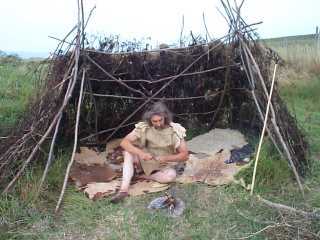Response to Boatman,
That's a really good point too. Homes need care, they need debris removed, fresh materials brought in, simply to keep them healthy let alone comfortable. On going repairs done in a timely fashion, not left until the roof caves in, etc.,
Looking round museum set ups of house interiors I cringe at the dust and dirt. The women who lived in those homes would be birling in their graves to think folks thought they lived in such squalor. Medieval halls were lined with careful plaited and sewn rush work and floored with fresh strewn materials. It can be quite lovely to walk and work in such an environment. Scents of the bedstraw, the yarrow, meadowsweet, and the bracken (unmistakable scent of the Crannog that one, even years later when I cut the bracken back that smell is so reminiscent) and the rushes, etc.,
Matts are quickly and simply woven from raw materials; they create not just mud free areas, but warm areas. They can be built up around an area too, as well as providing covering.
Tramps used to sleep under layers of newspaper, but grass mats work even better

Thing is though, almost all of those organics have long rotted away. Scattered and ploughed under into the fields, like the thatch roofs of the old cottages. Temperate climates leave very little really…unless the wetland sites, like the underwater excavations of the crannogs, reveal the plant material preserved in situ….all we really have as evidence are marks like those post hole arcs I mentioned.
Felicity Irons does some beautiful rush working
 http://www.rushmatters.co.uk
http://www.rushmatters.co.uk/images/pdfs/Rush-Matters-Milieu-article.pdf
http://www.rushmatters.co.uk
http://www.rushmatters.co.uk/images/pdfs/Rush-Matters-Milieu-article.pdf
Response to Paleocory,
I did read the post; that's why I wondered about the wisdom of the hole in the roof. He mentions more about the door flap than he does about the roof.
We found that the smoke filled cone of the roof space really does work well on brain tanned skins. It also cold smokes meat very effectively, if you get the height right. Leaves it shiny black, looking like ebony. It seems to preserve the timbers too though, and it definitely kills insects.
It's only the past couple of generations that have thought of smoke as a totally bad idea, but then we have the advantage of knowing what it does to lungs and throats and access to good insecticides and disinfectants.
Smoke made a home clean of disease and bugs in the past. Loads of hearth herbs have a long provenance too. From the mugwort to the juniper, sweetgrass to fomes

and the seasonal 'rites' of fires and smokes that cleansed animals and people too. Beltane fires for instance.
M

